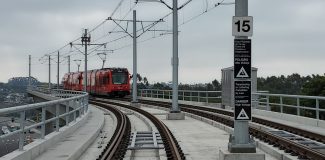Mid-Coast Trolley Project

The Mid-Coast Trolley Project, an 11-mile light rail extension of the University of California (UC) San Diego Trolley Blue Line, celebrated its official opening on Sunday, Nov. 21.
WSP USA, a leading engineering and professional services consultancy, served as the lead environmental and engineering consultant for more than a decade on behalf of its client, the San Diego Association of Governments (SANDAG). The firm was responsible for environmental, planning, preliminary and final engineering; New Starts funding advisory services; and design services during construction of the light rail extension operated by the San Diego Metropolitan Transit System.
As the designer of record, WSP was charged with advancing the $2.1 billion project from environmental clearance and conceptual engineering through construction, including track and systems design and operations analysis, station design, traffic engineering, civil and utilities design, and structures design. WSP also provided grant procurement services that led to a $1 billion Federal Transit Administration Full Funding Grant Agreement in 2016, clearing the way for construction to begin. The project was completed on time and on budget.
The extension provides a critical new connection for San Diego, extending the light rail line from the Old Town Transit Center north to the University Towne Centre (UTC) Transit Center in University City. The UC San Diego Blue Line now provides a one-seat connection from UTC to downtown San Diego, and south to the U.S.-Mexico border.
“At a time when we are witnessing rapid population growth in this popular section of San Diego, the Mid-Coast Trolley is arriving to provide critically needed public transit service along this highly congested corridor,” said Kimberly Jaskot, WSP project manager for design services during construction.
“This project presented many unique technical challenges, including difficult geological conditions, utility conflicts, adjacency to an active railroad, and construction in an urbanized environment where impacts to businesses, schools and medical facilities had to be carefully mitigated as part of the design development,” said Vladimir Kanevskiy, engineering technical lead for WSP. “We are grateful to have been part of a project team that was able to collaborate and successfully manage and overcome all of those challenges.”
“It’s been rewarding to partner with SANDAG on the delivery of the largest infrastructure project ever undertaken in the region and to help them achieve major milestones throughout environmental clearance and construction of such an important transportation project for the region,” added Kristin Carlson, WSP project manager for environmental support.
In addition to 11 miles of new double tracks, the project included the design and construction of eight bridge crossings, nearly seven miles of at-grade alignment in or near existing railroad right-of-way, more than four miles of aerial viaduct structures, and nine stations – five at-grade and four aerial. The project also included 1,170 new parking spaces at five of the new stations.
WSP also brought expertise in supporting the construction manager/general contractor (CM/GC) contracting process for SANDAG, including integration of the design team with the CM/GC pre-construction services team.
WSP brought together and managed a team of sub-consultants, closely coordinating with SANDAG’s team and consultant partners to advance and deliver this project. The team included TYLin International in partnership with HDR, program management; Jacobs and PGH Wong, construction management; and the Mid-Coast Transit Constructors CM/GC team, a joint venture of Stacy and Witbeck, Herzog and Skanska.


